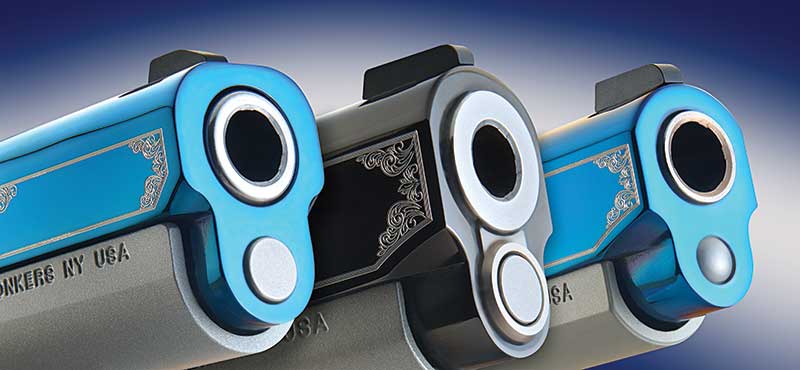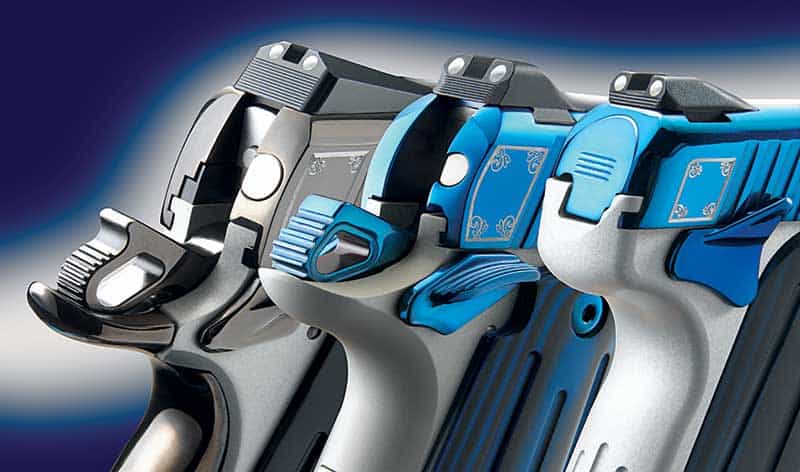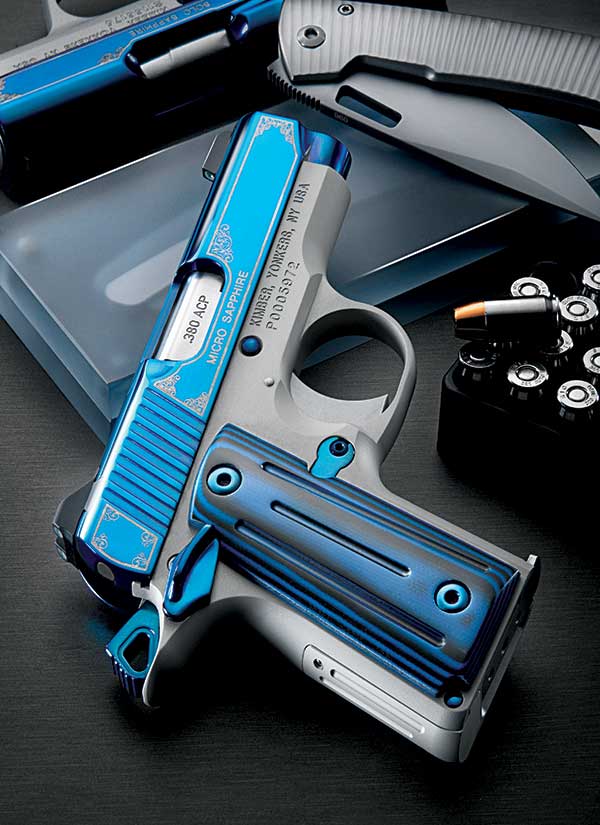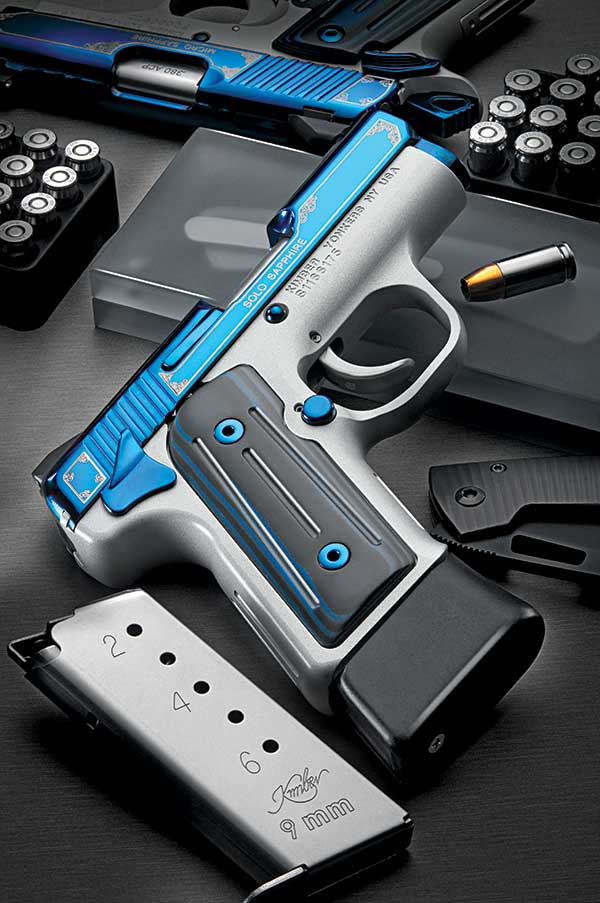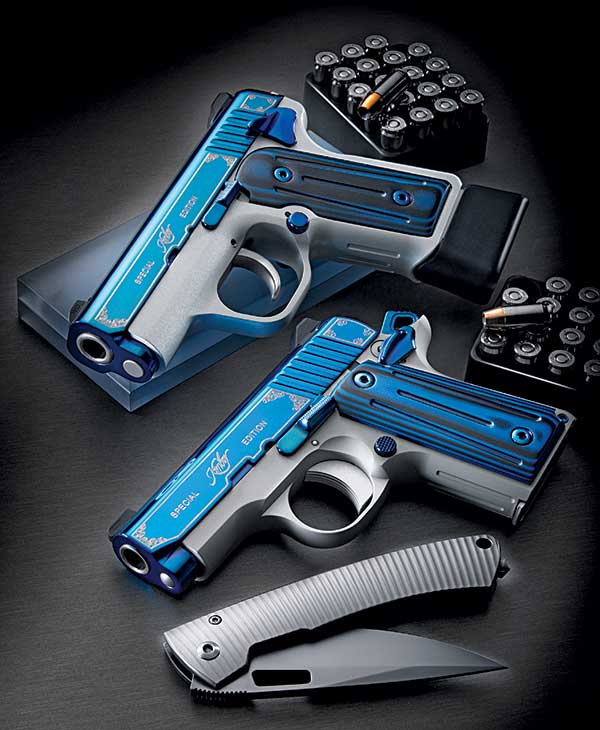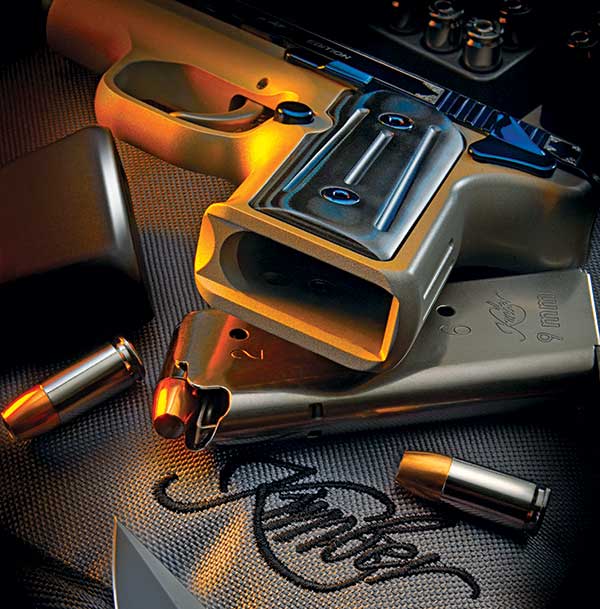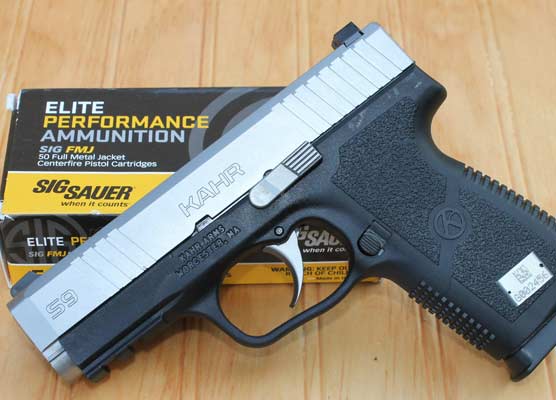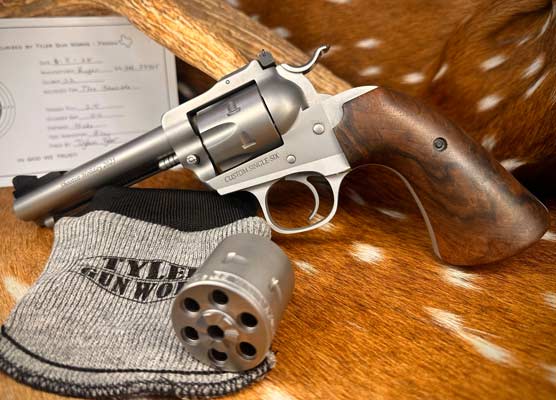A Kimber Trio .380 & 9mm
Special Edition Elegance .380 & 9mm
While it seems pink and purple may be “in” today in the “let’s get the gals to buy guns” market, in reality, many (dare we say, most?) women shudder at being sidelined like this. “Paint it pink and they’ll buy it, by golly!” is driving all too many marketing movements — and many women I know are tired of it.
My wife, Suzi, a retired cop, hunter, high-performance motorcycle rider, former editor of our American COP magazine, business owner and — let’s just say she has opinions — has been in the industry for decades. I asked her about “pretty-colored” guns:
“I can’t stand the Barbie pink, lime green and worse they’re foisting on us these days. If the pink honors breast cancer awareness and/or donates to the cause, women I know will support it. But otherwise, don’t marginalize women shooters and assume we all want to carry pink. I like to train with men because if I ever have to fight, it will most likely be against a male aggressor, so I like to know what they can do. Most women I know are not delicate flowers. We want real guns for the real world, not playthings.
“But … we do like to class things up at times, and these Kimbers are, well … classy.”
Less Is Enough
Kimber’s selection of a very limited palette of finishes on their Special Edition pistols seems to strike a universal chord with both women — and men. Understated elegance rather than glitz seems to be the choice here. The Sapphire models — Solo Carry Sapphire (9mm) and Micro Sapphire (.380 ACP) — as well as the Onyx Ultra II (also in 9mm) ooze class and look as if they should be accessories for your new Rolls Royce. Perhaps fitted into rare wood cases between the seats? Yet, each model is as feature-packed as any other performance-driven Kimber.
There’s the painted-on, diamond-stickers and glow-paint “class” some think catch the eye — which is fine, if this is what you want — but I think elegance of design and function, enhanced by tasteful embellishment, is hard to beat.
As Elmer Keith once said about ivory grips: “They’re like lipstick on a pretty gal.” Natural beauty or design excellence only needs a touch of something to lure the eye to look even harder.
That Amazing Finish
Let’s talk about the great blue and black color and finish. What exactly is it, anyway? Kimber’s website says it’s a “PVD” finish, standing for “Physical Vapor Deposition.” A bit of research turned up a PVD finish simply means a finish (usually a hard finish like Titanium Nitride) applied in a vacuum with vaporized substances to coat the substrate metal. This lays down a very thin layer of the finish applied (the blue or black may be from a number of different substances), but since this method is used to apply ultra-hard finishes to things like mills, drills and cutting tools, a thin layer can still wear exceptionally well and I’m inclined to think Kimber’s blue and black may be a hard finish.
It’s not “bluing” in the standard thinking. Think of it as an exotic finish of some sort, applied with a modern method helping a very old industry keep up with the 21st century. I’m guessing Kimber found a finish which turned out stunning colors, then figured out a great use for it. The Onyx II 1911 also has a PVD applied finish, which happens to be black as opposed to the blue.
The Micro .380
The small-fry of the trio, the Micro Sapphire in .380 is likely recognizable as having a heritage involving not a few genes from the Colt Mustang-type designs. The tiny .380 was so popular, it only makes sense to keep the concept going, and Kimber’s take on it is slick, nimble and runs great. Once you can tear your eyes off of the compelling blue finish and cut scroll engraving on the slide, you’ll see under the charm lies the body of a true defensive pistol. Being based on a design introduced a few years ago by Kimber, this new rendition has upgraded cosmetics, but is the same basic pistol.
Think “tiny 1911” and you’ll understand what we have here, complete with ambi-safety, tritium night sights, spur hammer and match-grade solid aluminum trigger. There’s also a passive firing pin safety which clears the firing pin as the trigger is pulled.
The factory trigger pull is set at seven pounds (my test gun was 6.75 pounds) and while this seems like a lot in a tiny gun like this, it works fine. If a fat finger is jammed into the small trigger guard, having those couple of extra pounds there helps to keep things under control. The pull itself broke pretty cleanly and seemed to smooth up a bit with use.
At only about 4″ tall and 5.6″ long and a shave over 1″ thick, weighing a feathery 13.4 ounces, it’s a true pocket pistol. The Micro also has had a full “melt” treatment for easier carry, runs on a full-length guide rod and helps keep weight off by using an aluminum frame. The frame has ball-end-mill grooves on the front and the mainspring housing is also grooved, matching the grooved, laminated G-10 grips.
This little gun is loaded with big-gun features and feel, and the retro-guy in all of us will enjoy the tidy match it makes to your full-sized carry 1911. While it would make a fine primary carry pistol for some, I think it shines as a back-up to a full-sized horse pistol.
Shooting The Micro
I put about 300 assorted .380 factory loads through this little gun and it ran like a top, once I had the first few mags through it. Kimber recommends all of their autos be broken-in by shooting before you carry it. A firm wrist is important in any little gun like this, so keep it lubed and shoot good ammo in it and it will run fine.
A bit of rested shooting at 15 yards showed it tended to shoot a few inches high, but held groups hovering around 2.5″. There’s nothing wrong with this in a tiny pocket pistol and groups were consistent regardless of bullet weight. Centered torso shots at 25 would be easy if you worked the trigger well. Recoil is snappy, but frankly, if you complain about it you’re making a fuss about nothing. I liked this little gun, and Kimber says the MSRP is $1,014.
The 9mm Solo
I really enjoyed this portion of the test since I’ve been carrying a Solo as my daily-carry gun since their introduction a few years ago. After having about a half-dozen go through our writer’s hands (and three through mine) I became convinced the Solo was a solid design. My own gun is chasing upwards of 1,200 rounds through it give or take some, and it runs just fine. I keep it very clean, lubed with light grease and a touch of oil here and there, and shoot 147-gr. sub-sonic ammo in it. Hitting an 8″ steel target at 25 yards is easy if you manipulate the trigger carefully. All of the Solo’s we’ve tested have been very accurate.
Our Sapphire beauty is vintage Solo, being a striker-fired semi-auto, 6-round compact mag (8 rounds in the extended one) and weighing about 17 ounces. Interestingly, it’s virtually the same size as the Micro .380, being 1/10″ shorter and 0.5″ longer and essentially the same width. The Micro, being only 13.4 ounces is slightly lighter, but who can argue over a couple of ounces? For me, I’d go with the 9mm every time.
The external, ambi-safety is handy and can be used or not, as you see fit. I use mine. The frame is lightweight aluminum and of course the metal bits have the wonderful blue/sapphire finish. The same enhancements exist as on the Micro, with cut scroll and border engraving on the slide and well-designed grips and grasping surfaces. The ambi-safety and ambi-mag release means even a lefty can run the Solo just fine. Other features include tritium fixed sights, an external extractor and a pre-loaded striker, which becomes fully cocked as the very smoothly functioning trigger is pulled toward release.
There is a cut-out in the breach area of the barrel so you can peek inside to see the glint of a loaded round, but remember, this just means there’s a case there, not necessarily a loaded round. There’s nothing like actually looking to make sure.
Workmanship was, simply put, as flawless as I’ve seen on a factory-produced gun, mirroring what I saw on the Micro and the Onyx II. There’s obvious attention to detail evident, and the fit and finish of the parts are consistent and sound.
Shooting The Solo
As to the test gun, I was curious to see if a new production model was different than my old one. I was pleasantly surprised to note the trigger pull on the new Solo was the same smooth, longish DA-like pull and our pretty blue test gun shot great. It took about 100 rounds before it ran smoothly, which is typical of the breed and of our prior test guns. Once lightly broken-in, it was as delightful to shoot as my old standby.
Being very familiar with the platform I shot it quite a bit, using light bullets (115’s) through the gamut to the heavy 147-gr. loads. After about 450 rounds, I noticed a few things. Using high performance lightweight bullets (think: 124-gr. personal defense-type stuff) recoil was snappy and you had to pay attention to follow-up shots.
I found (as I have with my old Solo) an extremely firm grip, even harder than I would shoot on a 1911, for instance, makes good sense. If you want to keep control, squeeze it hard, use both hands if you can, and you’ll not only help the gun to run better, but you’ll be well in control of things, with no need to constantly re-adjust your grip between shots. Watch shooters at the range and you’ll see them doing this all the time. And that’s a bad thing.
Interestingly, I found the heavier-bulleted loads — but non-plus-P stuff — to be very controllable and accurate. My own favorite of a 147-gr. sub-sonic from Federal yielded the smallest groups (hovering around 1.7″ or so at 15 yards) and were close to point of aim. I chronographed the same loads from a 5″ 1911 and they read an average of 1,025 fps.
From the 2.7″ test gun barrel, the same ammo hovered around the 890-fps range. Amazingly, the five shots over the chrono read: 888, 886, 893, 884 and 891 fps. I honestly have no idea why they were so consistent (I had about an 80-fps spread with the 5″ barrel) but this would certainly help accuracy.
All of the loads shot fine and the usual drill of a very firm grip, well-lubed gun and good ammo meant once break-in was finished, the test Solo ran fine. I really trust these little guns, and in about the same space as a small revolver, you can drum-up seven to nine shots!
A tip when cleaning though. There is a tiny wire spring holding the slide release in place, offering a bit of “downward” pressure on it. When you reassemble the gun, pause to make sure the spring is over the nub of the slide release which pokes into the gun. If not, you’ll get slide locks and it will drive you nuts trying to figure out why your gun has suddenly quit running right. MSRP on Kimber’s website is $1,291.
Onyx Ultra II 9mm
The surge of interest in 9mm 1911 platforms drove me to request our test gun in 9mm. And I wasn’t disappointed at all. Based on tried and proven Kimber 1911 designs, the Onyx Ultra II is, like the Sapphires, simply “beautified” and made even more enjoyable. With many of the same features as the others (ball-end mill work, custom grips and back-strap, ambi-safety, tritium fixed sights and cut scroll work and border on the slide), the Onyx Ultra II is a sort of “biggie-sized” version of the Micro (or vice-versa?).
At about 25 ounces, thanks in part to the lightweight aluminum frame, the Onyx Ultra II carries handily. If your hands are automatically familiar with a 1911, you’ll feel right at home here. The full-length guide rod may toss a wrench into things taking it apart, but other than this, you’ll be on familiar ground. The frame is slightly “melted” and the gun feels very comfortable in the hand. The 3” barrel means the sight radius is short, but the modest recoil of the 9mm in the “about” Officer-sized grip translates into an easy-to-control gun.
The 8-round capacity, in spite of the shorter grip, gives you nine rounds in the gun and the bold tritium sights helped me to shoot consistent 1″ to 1.5″ groups at 15 yards. I think this gun would shoot well at 25 but I also think the 15-yard distance makes more sense for this model. The very friendly 16-pound recoil spring (remember, we’re in 9mm mode here) means the slide is easy to run and would likely be a great match for a smaller-statured lady or perhaps someone who has a disability, making it difficult for them to manipulate a stronger spring set-up.
With the slight melt going on, and the gently rounded butt-point, the Onyx Ultra II felt delightful in the hand and on my hip in several holsters I tried it on. As a matter of fact (and with a 9mm magazine from another maker on hand to test), I uncrated a good cross-section of 9mm ammo and went to work. I was really looking forward to shooting it extensively. Over two days, I put an honest 650 rounds through it, with some help from a good friend here. I had exactly two failures of the slide to close home within the first three or four magazines, then the gun ran 100 percent. This is just fine, in anybody’s book, once break-in was done.
I squirted a bit of oil on the rails and a couple of other points about halfway through, and we had great fun running plate racks at about 10 yards. The more I shot the Onyx Ultra II, the more I liked the idea of a 9mm in a compact package like this. If you’ve never fired a 9mm 1911, you have a treat in store. It’s not the strong thump of a .45, but more of a friendly “ka-chunk” feel. It also makes off-hand work much easier since the 9mm’s modest recoil makes controlling it off-hand much more predictable. MSRP on this model is $1,652 on Kimber’s website.
No Ugly Guns
My dad says, “Life’s too short to drink bad wine.” And with the cost difference between bad wine and good wine being a very modest amount, I make it a point to only have good wine around!
I think applying the same thinking to our guns makes perfect sense. Years ago, I realized it made more sense to sell off several guns which weren’t quite right, or models I enjoyed once but had fallen out of favor with me — and use the money to buy one really good gun! Now, I have fewer guns, but the ones I have are much more enjoyable.
Take a hard look at your own safe and ponder the possibilities lying within. Is it time to put some of the money to work, rather than let it gather dust in the dark?
Life is too short to shoot ugly guns? Hey, it works for me.


